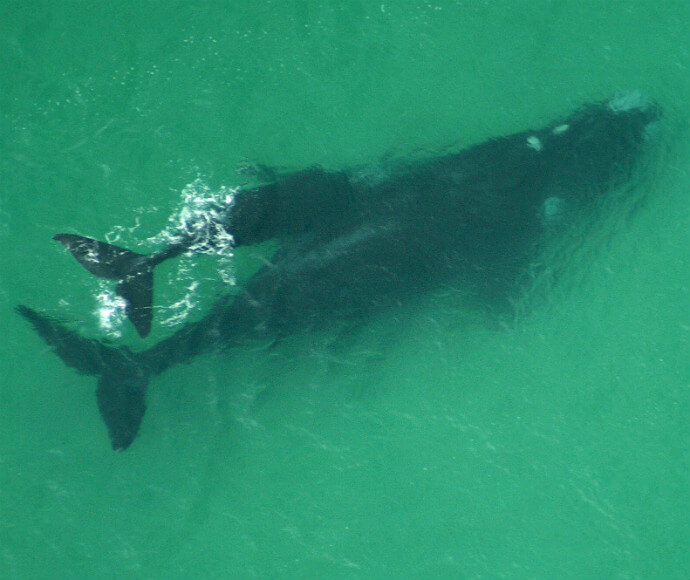What do they look like?
The features of a southern right whale (Eubalaena australis) are:
- dark skin, with irregular white patches on the throat and belly
- a round body which tapers to a relatively narrow tail stock
- a broad tail, with flukes which form a wide triangle with a notch in the middle
- large, broad pectoral fins, which have a rectangular shape.
Southern right whales can grow to about 17 metres long and weigh up to 100 tonnes. At birth, their length ranges from 4.5 to 6 metres.
All baleen whales have 2 blow holes. However, in most species the 2 merge into one. The southern right's 2 blow holes remain separate, producing a distinctive V-shaped blow, a cloud of vapour blown out when the whale surfaces to breathe.
Southern right whales also have a series of natural growths called callosities on the front of the rostrum or head. The largest of these callosities is called the 'bonnet'. Callosities are also found on the whale's chin, on the sides of the head, on the lower lips, above the eyes and near the blowholes.

Southern right whales visit southern Australia during winter.
What do they eat?
Southern right whales feed mainly on copepods, krill, mysids and plankton, among other tiny crustaceans. They are baleen whales – they don't have any teeth and feed by filtering food through 220 to 260 baleen plates which hang from each side of their upper jaws. The baleen is up to 2.8 metres long and is fringed by long, fine, greyish bristles. Southern rights hunt their prey by swimming with their mouth open and trapping their prey in their baleen bristles, while also filtering water out of their mouth.
Where can you see them?
Southern right whales visit southern Australia during the winter months, and they are increasingly found in NSW waters.
The whales are often seen in very shallow water, including estuaries and bays. They have even been known to swim in the surf zone. During these times, they are not known to strand.
Sometimes you can even be lucky enough to see mothers and calves together. They may play for a few hours or days in the same location, and it is important not to disturb them at these times. The calf is learning the life skills it will need before it returns to the Antarctic, and the mother can be very protective of her young.
Behaviour
Closer up, you can see southern right whales:
- rolling forward to dive, until only their tails stick out of the water – this is called a fluke-up dive
- raising their heads out of the water to look around – this action is called a spy hop
- lying near the surface of the water, with one or both of their pectoral fins above the water – sometimes they will be suckling their young.
Threats
In the early history of New South Wales, the southern right whale was a mainstay of the colony's export industries. It was thought that it was the 'right' whale because it swam slowly, floated when killed, and yielded high quantities of oil and baleen (whalebone). The whales were plentiful, and ships would stay for a while after bringing convicts to the colony to let their captains hunt southern right whales.
By the 1840s, southern right whales had been hunted out and the whaling industry had collapsed. Populations have been recovering ever since. Today, scientists estimate that there are around 5,000 southern right whales in the world.
Southern right whales are protected throughout Australia and are listed as a threatened species under the NSW Biodiversity Conservation Act 2016.
Quick facts
| Feature | Southern right whale |
|---|---|
| Length | Adults: 14 metres to 18 metres Calves: 5 metres to 6 metres at birth |
| Weight | Adults: up to 80 tonnes Calves: 1 to 1.5 tonnes at birth |
| Gestation | 11 to 12 months |
| Weaning age | 11 to 12 months |
| Calving interval | Generally 3 years |
| Physical maturity | Age: unknown Length: 16 metres (males slightly less than females) |
| Sexual maturity | Age: 8 to 10 years Length: 12 metres to 13 metres |
| Mating season | July to August |
| Calving season | June to August |
| Cruising speed | 3 kilometres per hour |
| Blow pattern | V-shaped bushy blow, up to 5 metres |
| Protected | Since 1935 |
Protection of native animals
All native birds, reptiles, amphibians and mammals, but not including dingoes, are protected in New South Wales by the Biodiversity Conservation Act 2016.